In the nights that followed the death of my grandmother, on the verge of sleep, I would find myself thinking about her house, the house where I had been born. Now that the house was sold and she was gone, I would try to recreate the experience of being in it, tracing a route through the space until a constellation of remembered objects hung in the darkness before my eyes. After a few months – or years – I grew tired of this task, now amounting to little more than ticking off things on a list that itself was fading. I decided to draw the space instead. The question was, how?
I asked an architect to draw the house as I described it – a process that required the use of my body as well as my voice. When I had finished, he had made thirteen drawings. I layered them one on top of the other, starting with the front door: 3 Redacre Road. Then I projected the tangled marks onto my studio wall, and proceeded again to work through the space, this time with pen and ink, or with charcoal, or, capitalising on the contingency of these materials, felt-tip pen. Once, the felt-tip ran out half way through and turned from black to purple. In another, pools of clotting ink erased portions of the drawing that outlined the architectural structure. Each drawing unfurled across rolls of paper – the largest I could find – before being rolled back up again and put into storage. They were too representational. My attempts to make them less so – to make them ‘abstract’ perhaps – made them instead seem fudged, almost contrived (fig.1).

Fig.1
Susan Morris
Architectural Drawing_Not Human 2008
Ink and shellac on paper
© Susan Morris
What was my body doing when I imagined, when I dwelt upon these spaces? I knew I was possessed of a set of movements that concerned the architecture, that may have once been housed by it, but that these were now embodied in the various gestures that made up what I recognised as my ‘self’, a self suddenly experienced as inchoate, thrown into disarray by the abrupt disappearance of the place in which they had been formed. I wanted some way of recording or tracing these unconscious movements, to catch the things I did, the gestures I made, all those things I did not know about, did not consciously think about.
With this in mind, I took out another roll of paper, extended it across the length of my studio (which is four metres long), and tacked it to the wall. I took a spirit level, a hammer and a plumb bob filled with black pigment made from the ash of vines. With the spirit level I drew a line across the length of the paper, close to its upper edge. On this line I hammered in a nail, attached the plumb bob and unwound the string. I waited for gravity to make itself master then flicked the string, now coated with vine ash, so that it hit the paper and made a mark. I repeated this process, following the horizontal pencil mark, and slowly covered the paper with vertical lines, some heavy with ash, some faint as the plumb bob’s hollow chamber emptied (fig.2). Some lines showed evidence of a string that was fraying; a broken string produced abrupt changes in the type of line recorded. Accumulating horizontally, and emerging alongside the sequence of tightly packed vertical lines over which I tried to maintain some sort of control, these irregularities hovered in an unexpected pattern across the paper to create a drawing that had essentially drawn itself, that had fallen or was cast from a body that fluctuated between ‘I’ and that which ‘I’ had no hold upon (fig.3).
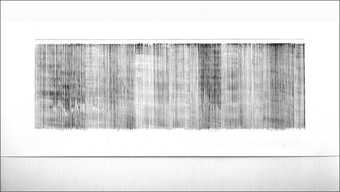
Fig.2
Susan Morris
Plumb Line Drawing_010 2009
Vine ash on paper
© Susan Morris
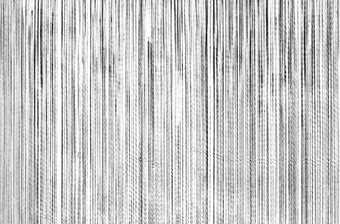
Fig.3
Susan Morris
Plumb Line Drawing_009 2009
(Detail)
Vine ash on paper
© Susan Morris
Vision is a part of being, yet, as French phenomenologist Maurice Merleau-Ponty suggests, there is no ‘fusion or coinciding of me with it’.1 ‘On the contrary’, he argues, ‘a sort of dehiscence opens my body in two.’2 The doubling up of it into an inside and outside, ‘turning about one another’ create a chiasm, so that ‘my “central” nothingness is like the point of the stroboscopic spiral, which is who knows where, which is “nobody”’.3 But not no body. On the contrary, the body insists on its un-writability, and on its being. These ideas perfectly articulate the problem of making a mark in relation to (as record of) being. How can one examine, pictorially, the representation of space when ones place within it cannot be found? It is absurd to think about representing my location within a room by drawing with marker in hand. Something of the enigmatic movements that accompany spatial awareness – what the literary historian Eric Santner has described as our ‘creatureliness’ – gets written over in the light of day. For Santner, spatial awareness – the sudden realisation that you are somewhere – can actually produce a sense of disorientation, of being thrown out of place. This is a ‘surplus animation’ that the subject is both ‘excited [and] constrained by’, which signals the presence of something ‘in excess both of our merely biological life and of our life in the space of meaning’.4 How might it be possible to access or record this? Only the methods discovered by those who try to see in(to) the dark will do: the maps, diagrams or recording devices used by scientists, cosmologists, geographers and psychoanalysts.5 Yet these must be combined with a certain blindness that corresponds to the darkness in which things are first sensed. ‘In a dark room, eyes wide open’, as the surrealist André Breton suggested, the artist must remove all conscious activity, all rationalistic thought, ‘and put nothingness in its stead’.6
As anyone who doodles knows, a line drawn inside a frame immediately demarcates a territory: foreground and background are implied.7 Space is structured by the addition (or is it a subtraction?) of this interval, this line. The sense of a horizon, of depth, of the spatial relation of one thing to another, clings to the field thus created and activates it, as if under the influence of some kind of external force. But the challenge might be – especially when dealing with the unconscious – to put lines in space that interfere or deactivate this field, that neutralise it so that it remains enigmatic, unstructured, empty or unbound, either on the brink of signification, or after its collapse.8 This is because the failure of this procedure, of drawing a line on a piece of paper, for the subject, is that it always leaves something out. As Merleau-Ponty claims, something of being is excluded in the very attempt to represent it, excluded by the process of representation itself, which, in order to signify, to make meaning, must engage with an Other.9 It must incorporate the Other – something that is not it, that is exterior to it – into its (representational) system. ‘Meaning comes from the Other’, as the psychoanalyst Darian Leader argues, ‘whether the subject knows it or not … This unfolding in the Other’, he continues, ‘is articulated like a discourse’, with subjectivity itself ‘formulated as a simple question: “What am I there?”’10
Tracking bodily movement and representing the space within which the body moves presents a problem because there is no space but the representation of space. In addition, ‘modern science’, as sociologist Roger Caillois argued in 1935, ‘has been producing increasing numbers of [represented spaces]’, in which the living creature ‘is no longer located as the origin of the coordinate system but is simply one point among many’.11 Examples Caillois gives include ‘Finsler’s spaces, Reimann-Christoffel’s hyperspace, abstract spaces, generalised spaces, open, closed, dense, sparse’; spaces in which the subject is driven, or lured into a kind of self-abandonment.12 Dissolving into ‘dark space into which things cannot be put’, the subject no longer knows where he is, or even that he is.13 Caillois correlates this phenomenon with the French psychiatrist Eugène Minkowski’s definition of schizophrenia, characterised by the subject feeling permeable to his or her surroundings. When asked where they are, he suggests, ‘schizophrenics invariably reply, I know where I am, but I don’t feel that I am where I am’.14
The space of being, of at-one-ness with the world, where one is not different or separated from it, has no form. The act of perceiving it, however, causes space to wrap itself around the perceiving subject, like threads pulled from the body. Space draws itself as one moves through it, in relation to a horizon line, to gravity and to one’s own verticality (which one can sense even with one’s eyes closed) and in relation to objects outside oneself, such as other people. Therefore, as Caillois suggests, space operates like ‘a double dihedron continuously changing its size and location’; an intertwining structure produced by and simultaneously excluding the subject.15 There is no representation without the Other, but no self either. How, then, is it possible to make a mark where being occurs?16
Working along similar lines around the same time as Caillois, the psychoanalyst Jacques Lacan also picked up on Minkowski’s intuition from Le Temps vécu (1933) ‘of another space besides geometrical space, namely the dark space of groping, hallucination and music, which is the opposite of clear space, the framework of objectivity’.17 This dark or empty space became an increasing part of Lacan’s thinking around how a subject lives in language and his or her existence outside of it. In 1936 he introduced the first ‘logical pattern’ to his teaching – the Schema L (fig.4) – the letters of which, in ‘dislodging the place of words’, correspond, as Darian Leader has noted, ‘to an emptying out of meaning’.18 Schema L represents a set of relations in which the subject, stretched across four corners, is involved as ‘participator’; at S, in ‘his ineffable, stupid existence, o, his objects, o’, his ego, that is, that which is reflected of his form in his objects, and O, locus from which the question of his existence may be presented to him’.19 Lacan came to see that diagrams such as these could contain something that equates with the empty and unrepresentable spaces described above – with what he categorised as the Real – and insisted that they should not be seen merely as representations of the split nature of the speaking subject, but as the structure of subjectivity itself, understood as ‘a set of relations of invariance’.20 Here the idea of a unified subject becomes dissolved, broken down and suspended across the four corners of a schema that also operates as a kind of housing, an architecture, for that wordless thing which one is not, as well as for what one is in language, in other words, what one is in the Other.21
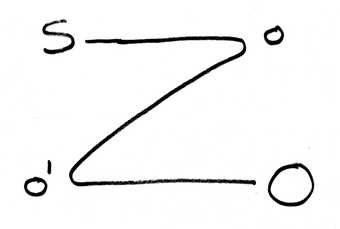
Fig.4
Simplified version of Schema L
Courtesy Trevor Horne
As Lacan’s ideas evolved he started to use topological models, beginning with the Möbius strip.22 The structural, mathematical, properties – or surfaces – of these models serve as analogies for the continuity between inside and outside, for the intertwining of self and other, and for the problematising of ‘normal’ binary oppositions produced by language, all of which Lacanian theory insists upon. However, these models always retained something of the fundamental structure established in the Schema L. This is because, as Leader argues, ‘any formalisation of the structure of the subject’, once the unconscious is taken into account, must be ‘quaternion’.23
For André Breton too, ‘there is an architecture that certain individuals consider the only true abode … where the distinction between subjective and objective ceases to be necessary or useful’.24 Here, he suggests, something persists – a force that holds things together in ‘clusters … formulated outside (some would say beyond) articulated language and reasoned thought’. In order to tap into, trace or record what is there, ‘as if taking a print from nature’, one should, Breton declares, throw one’s self ‘into the dark recesses of being’, into a magnetised ‘state of grace’ to which ‘automatism alone provides access’.25
Breton would have been aware of the scientist and chronophotographer Étienne-Jules Marey’s research into ways of revealing forces, such as the tremors of the body, that are felt but not seen, which had led to the development of devices like the sphygmograph.26 Worn on the wrist, this used a stylus and a rotating drum, blackened with soot, on which the heartbeat could be inscribed as a graphic trace. Other experiments studied the pattern and behaviour of smoke as it was blown around obstacles. Photographing the suspended particles provided information about the natural forces on which they were borne and, in an intertwining of the visible and the invisible, phenomena such as air currents could thereby reveal themselves.27
In her analysis of the work of Agnes Martin, art historian Rosalind Krauss proposes that her paintings contain something ‘atmospheric’ (fig.5).28 According to Krauss, this entails something ‘mist-like’, but it is also intended as an effect ‘within a system in which an opposite effect is also at work’, transforming ‘atmosphere from a signified (the content of an image) into a signifier – /atmosphere/’.29 In other words, Martin’s paintings appear to contain or point towards something invisible, outside or beyond representation, in the way that Marey’s smoke particles revealed something that does not appear to exist, except, perhaps, as absence. Through the medium of photography, Marey found ways to bring to light something akin to what Marcel Duchamp referred to as ‘an invisible fourth dimension, something you can’t see with your eyes’.30 In the case of Martin’s paintings, where modes of representation are at stake, that invisible thing is revealed as empty, a container for meaning where no meaning actually resides. This, as the Lacanian writer and analyst Jacques-Alain Miller suggests, is a peculiar by-product of language, which produces a ‘nothingness’ that is different from invisible natural forces such as air currents.31
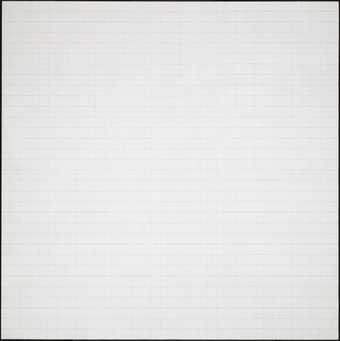
Fig.5
Agnes Martin
Morning 1965
© Estate of Agnes Martin / DACS, 2015
Krauss’s argument draws on the French philosopher Hubert Damisch’s A Theory of /Cloud/: Toward a History of Painting (2002), a book ‘that rewrites the history of Renaissance and Baroque painting according to a system in which the signifier /cloud/ plays a major, foundational, role, that of a “remainder” – the thing that cannot be fitted into a system but which nevertheless the system needs in order to constitute itself as a system’.32 The ‘perfect illustration’ of this can be found in the apparatus that the Florentine architect Filippo Brunelleschi used in his first experiment on perspective, which ‘slips in’ something that cannot be measured: the ‘unanalyzable surfacelessness of the clouds’ reflected in an area of silver leaf on the painted panel that mirrors the real clouds and embeds them into the viewed image (fig.6).33 In this way the apparatus indexes the subject who looks through it as an immeasurable body in space and time. For perspective to work, ‘the vanishing point and the viewing point must be geometrically synonymous’.34 If one were to reverse the arrows in the drawings of Brunelleschi’s mechanism that follow the horizon to its vanishing point through a series of holes, then the subject would, so to speak, be out of the picture. Thus the position of subjective mastery implied by perspective is in fact an illusion generated by the very thing – the gap or hole – that reveals it as such. From this point, Krauss argues, painting (and other modes of representation) understood that its ‘scientific aspirations – towards measurement, toward the probing of bodies, towards exact knowledge’ are always conditioned by the unknowable and unrepresentable: ‘If the /architectural/ came to symbolise the reach of the artist’s “knowledge”, the /cloud/ operated as the lack in the centre of that knowledge, the outside that joins the inside in order to constitute it as an inside.’35 For Krauss, once there is ‘/cloud/’ there is ‘grid’, an ‘atemporal [and] non-spatial’ form.36 With the addition of /cloud/’s ‘remainder’, painting re-organises itself and moves from depicting ‘the subjective experience of the empirical field’ to what could be termed ‘subjectivity as such, subjectivity now construed as a logic’.37 This is because the grid displays perfectly ‘the conditions of the visual’; as an articulation of ‘objectivity and extreme clarity’ intertwined with its opposite, vision as simultaneity, where the spatial separation of figure against ground dissolves into a ‘continuous immediacy of a purely optical spread’.38
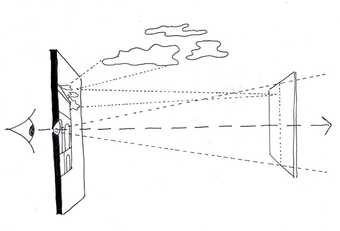
Fig.6
Diagram of Filippo Brunelleschi’s first experiment
Courtesy Trevor Horne
His Twine was Marcel Duchamp’s contribution to the First Papers of Surrealism exhibition in New York in 1942. Subsequently titled Mile of String, the work consisted of several hundred feet of twine stretched across and around the room where the other exhibits were put on public view (fig.7). In the photographs that document this event, the space appears sliced up, disorganised, with prospective viewers barred from a fragmented room that seems to hang like a pane of broken glass caught in the micro-second before it shatters. Although in reality viewers could reach most of the works quite easily, the photographs emphasise the twine’s interference with the viewing subject’s sovereign position; they seem to contain something that insists on the meaninglessness of that position, like ‘optical glitter organized into the very weft’ of the viewed objects.39
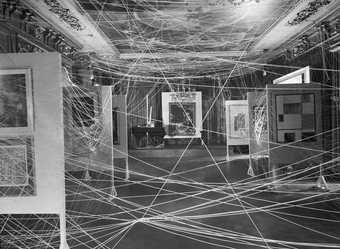
Fig.7
John D. Schiff
Installation view of First Papers of Surrealism exhibition, showing Marcel Duchamp’s His Twine 1942
Gelatin silver print
Gift of Jacqueline, Paul and Peter Matisse in memory of their mother Alexina Duchamp
Philadelphia Museum of Art
Duchamp himself tended to stress the functional value of His Twine over its symbolic meaning, that is, as veil or obstruction.40 Indeed, as art historian John Vick has pointed out, the exhibition was not rendered impassible by Duchamp’s intervention. Rather, His Twine created gaps through which to peer, thereby reordering or mediating the viewing experience.41 Duchamp himself ‘was keen to downplay, even deny, the obstructing quality of his twine’, yet the photographs taken by John Schiff – the best known and most consistently cited photographs of the installation – actively encourage this reading.42 Although His Twine was ‘more permeable, and the art on display more accessible’ than many believe it to have been, Schiff’s photographs ‘suggest a separation’ between the viewer and the art, the gallery appearing to be ‘closed-off by a web of intersecting lines’.43 Schiff’s photographs can therefore be seen as substitutes for the work’s original intended meaning or effect. As Vick suggests, the photographs, in staging a ‘dynamic interaction with the twine … encourage the practice of looking through [holes]; they actually document that experience’.44
Two photographs of the installation by Arnold Newman reinforce this view. In both images, which feature Duchamp somewhat tangled in his web, His Twine functions as a framing device. One of them shows the artist standing beside his painting Network of Stoppages 1914 (Cimetière des Uniformes et Livrées; Museum of Modern Art, New York). As Vick argues:
That Duchamp was posed beside this particular painting is not a coincidence. Cimetière des Uniformes et Livrées … is a layering of imagery derived from other paintings and drawings, the top level being the synapse-like forms of 3 Standard Stoppages (1914), made by dropping meter-long threads from a height of one meter onto a horizontal surface. In other words, Newman’s photograph shows a painting behind twine of a painting behind twine. A more reflexive image could hardly be imagined.45
Duchamp’s designs for the First Papers of Surrealism catalogue – using imagery such as bullet holes, Swiss cheese and a keyhole – also serve to ‘emphasize permeability and the process of looking through’.46 Experimenting with sight, as Vick points out, was one of Duchamp’s lifelong preoccupations, manifested most notably in works such as To Be Looked At (From the Other Side of the Glass), With One Eye, Close to, For Almost an Hour 1918 (Museum of Modern Art, New York), not to mention Étant donnés 1946–66, the artist’s enigmatic installation in the Phildelphia Museum of Art consisting of a naked female torso lying on her back in a verdant landscape, which can only be observed voyeuristically through peepholes in a door.47 Indeed, Vick argues that, ‘[s]ince the First Papers of Surrealism catalogue includes a reproduction of Duchamp’s In the Manner of Delvaux (1942), a collage showing a fragmented view of a female nude, Étant donnés may have already been on Duchamp’s mind’.48
Another work by Duchamp, Unhappy Readymade 1918, may have served as a precursor to His Twine and the artist’s interest in the permeability of visual, spatial and sexual forms. Consisting of a geometry book, which Duchamp’s sister Suzanne and her husband Jean Crotti were instructed to hang by strings from the balcony of their apartment in Paris, Unhappy Readymade was conceived by Duchamp in a letter to his sister as a wedding present. Later, Duchamp explained his intentions for the work:
the wind had to go through the book, choose its own problems, turn and tear out the pages. Suzanne did a small painting of it, “Marcel’s Unhappy Readymade”. That’s all that’s left, since the wind tore it up. It amused me to bring the idea of happy and unhappy into readymades, and then the rain, the wind, the pages flying.49
As art historian David Joselit notes, ‘like many of Duchamp’s readymades, this one perished. Or rather, it was intentionally designed as a catalyst whose physical form would disappear into the various visual and textual reverberations it provoked’.50 By engaging the services of both the weather and his sister, Unhappy Readymade reverberates with the ideas that Rosalind Krauss raises in relation to Agnes Martin’s paintings, about subjectivity being cut through with something unmeasurable and cloud-like. It can also be described as a collaboration, through which Duchamp orchestrated another mode of looking, this time through his twin. Indeed Unhappy Readymade may be the first of a series of works that, as Krauss suggests, ‘announce a self that is split, doubled’ into an I and a (female) other.51 Duchamp’s later conjuring of his female alter ego Rrose Sélavy firmly established his artistic investigation into twinning or doubling and the place of femininity within the field of vision, a place, that is, without spatial or temporal limits. Indeed another readymade, Belle Haleine, Eau de Voilette 1921, which consists of an empty perfume bottle with a label featuring the face of Duchamp as Rrose Sélavy, determines feminine subjectivity as vaporous and diffusive – a hanging, atmospheric, ‘female thing’ – which opens up the body and the space it occupies like ‘beautiful breath’.52
Tacita Dean’s tri-part film Boots 2003 (fig.8) features an eponymous character who takes a journey around a house with which he appears to be familiar. Oblivious to the camera, Boots, who also provides the voiceover narrative, weaves about the building spinning a story about his relationship to the place and his memories of someone – a woman, an ex-lover, perhaps – who used to live there and who now casts a shadow. His footsteps are an echo of her (apparent) melancholia. But Boots does not seem to stick to a particular script; contradictorily, contrarily, he heads off on his own and festoons the place with the absence of her. In the special shoe he wears to make up for the shortness of one of his legs, he limps, as philosopher Jean-Luc Nancy has commented, ‘through the cloisters, passages and temples of the vast memory without memories … his lameness gives its rhythm to the space of the place in which he moves’.53 The echo of Boots’s footfall animates the building and the three separate interlocking paths taken through it (each narrated in a different tongue: German, French and English). But where is he? What time? What place? Hanging, perhaps, between the stories that trip off his tongue and the building itself which guides him, and to which he spontaneously responds. Yet he makes these movements blindly. Why? Because he does not know in advance either what he is going to say or where he is going. In this route, remembrance is at play; blind, involuntary memory, which takes him through a set of spatial co-ordinates as yet unwritten, and which, in the aftermath of the three meandering and separate journeys, accumulate as a spidery trace that lingers like an hallucination or afterimage, indexing something, or nothing.
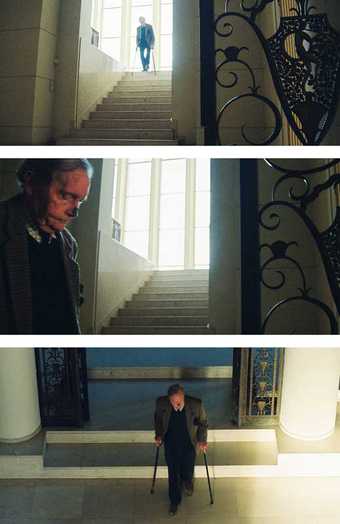
Fig.8
Tacita Dean
Boots 2003 (film stills)
3 films (English version; French version; German version)
Each film: 16 mm colour anamorphic, optical sound, 20 minutes
© Tacita Dean, Courtesy of the artist and Marian Goodman Gallery, New York / Paris; Frith Street Gallery, London
Recorded in the ‘fragile … trembling’ medium of film, which nevertheless has the deictic, indexical attributes of the photograph, what Boots pieces together refuses memory or mere attachment to place, and does so as a demand for life, lived in the here-and-now, as opposed to in a chronologically ordered past.54 The rooms, full of windows and mirrors, can neither frame nor contain the voice that echoes within them, which offers up something un-recitable, shot through with hesitations, reversals, garbled profanities and probably the occasional lie; an evasive autobiography as a skein of what the painter Max Unold, writing about Marcel Proust, calls ‘pointless stories’ that can only find form within an artwork that brings all the threads together in a ‘Penelope work’ of remembrance, that is, to echo the philosopher Walter Benjamin’s commentary on Proust, one tied to forgetting.55 Involuntary recollection – ‘Proust’s mémoire involuntaire’, as Benjamin suggests – is ‘much closer to forgetting than what is usually called memory’, and Proust’s novel In Search of Lost Time (1927) becomes for Benjamin a ‘work of spontaneous recollection, in which remembrance is the woof and forgetting the warf’.56 Thinking along these lines it may be possible to suggest that Boots is also a ‘Penelope work’, an anti-narrative of being, where remembrance and memory, ‘one diurnal, the other nocturnal’, operate at the same time ‘like a tide on the turn’.57 The curious suspended and invisible trace of this operation becomes apparent only somewhere between the simultaneous unreeling of the three films, between their three separate but intertwined locations.58 In the space so formed, Boots tells us pointless stories that stretch to infinity, during which the absent woman hangs in the air like perfume.
Study for L’Aubade, May 5th 1942, the last in a series of preparatory studies by Pablo Picasso for the large painting L’Aubade 1942 (Centre Pompidou, Paris), resembles uncannily the web-like shards of Duchamp’s His Twine, a coincidence made all the more remarkable by the fact that the two works were made independently just months apart. Indeed, like Duchamp’s installation, Picasso’s drawing represents, in the words of art historian Leo Steinberg, ‘a controlled grid of multiple spatial directives’.59 Moving in parallels, the lines ‘define intersecting space lanes – like star trails, directions for indoor galaxies’. Given, however, that ‘each single line also converges somewhere with another … to convey vanishing points to dispersed destinations’, Picasso’s drawing, argues Steinberg, merges two themes that serve as counterpoint: ‘indoor space lanes and lines of sight, criss-crossing in a kind of charted ubiquity.’60
The drawings that precede this ‘final abstraction’, such as Furnished Room with Sleeping Nude, September 1st, 1941 make explicit Picasso’s primary interest: the space of the occupied room, which, as I have argued above, implies an architecture, a structure, and a body.61 For Picasso, the body from which this investigation begins and extends is that of the sleeping woman – ‘the great reservoir’ – the means by which the artist constructs a point of view from outside his own self in a manner that recalls Duchamp’s doubling and coupling of visual and sexual forms. Through the act of drawing, Picasso stretches lines of vision out from the body of the woman and across the four corners of the room. Slicing through the visual field, these lines give the impression of things being seen simultaneously from several different poles, as if the artist, imagining a normal perspective grid, had projected himself to the vanishing point in order to look back at his objects, ‘like a photographer looking back at his delayed-shutter camera’.62 These overlapping lines could, Steinberg suggests, be understood as representing ‘one woman in successive positions’, like multiple exposures: ‘the sleeper’s motion in contracted time’.63 However they could just as well ‘represent antipodal points of vantage trained upon a body at rest’, in other words, the sleeping woman could be still while the artist moves, his eye roving across a recumbent body. ‘One may think’, writes Steinberg, ‘of an ambulating or periscopic curiosity, of a lens on a circular rail moving about its target.’ The viewer’s fixed point of view is thus ‘stretched into an arc’.64
Picasso’s preparatory studies for L’Aubade, though undeniably challenging the conventions of pictorial representation, rarely concede to pure abstraction. Rather, they are both diagrammatic and, recalling Eric Santner, ‘creaturely’. The impulse behind the drawings is to try and undermine and ultimately destroy the fixed subject position, while always (melancholically) remaining trapped in it as ‘maker’. Thus, Picasso exchanges a system of looking that is organised by and from a centred, fixed viewpoint, for one that sends things flying in all directions, like the pages from Duchamp’s Unhappy Readymade, or that rakes through and scatters the visual field, in the manner of His Twine, such as in Furnished Room, September 1st, 1941.65 Yet there is control. As ‘magnetized intervals’ that give shape to ‘nothings’,66 the lines reform, according to Steinberg, ‘as a network or grille’.67 This is why, Steinberg suggests, Picasso’s drawings are so frequently ‘splayed out’ – the field stretched ‘clear and taut [as if] for the charting of information’ – with forms ‘gnomonic, quincuncial, homolographic’.68 But it is also why he draws like a machine, as if with ‘the style on a kymograph’, an apparatus more suitable for the capturing of natural forces such as a wave or the tremors of the earth.69 The bodies of the sleeping women are thus rendered ‘as if on a rotating shaft’ with lines that trace a ‘hithering transverse’.70
In Furnished Room, August 25th, 1941, one of the last three ‘furnished room’ drawings that he made before painting L’Aubade, Picasso depicts spaces that ‘double and twist so that the whole room heaves like a house of dreams’.71 It is as if the artist’s vision has been tracked using technology such as a motion capture device, or as if he had been holding a light and moving it during a long exposure. The drawing captures trails of movement that leave the room, in Steinberg’s words, ‘traversed by an irregular network of intersections’, with the fragmentary and simultaneous elements making the flat field of the canvas ‘operate within the picture as would a chart, blueprint, or engineer’s drawing’.72 Picasso cuts the strings that attach him to a fixed, perspectival point of view. Space is reconstructed, but as broken shards that reflect back this new viewing position, or lack of it. The space and the bodies within it undergo a kind of disintegration, a collapse, becoming inarticulate, chaotic. Faces are ‘pared down to the features you knew the names of when you first learned to talk … signs that stand for eye, mouth, nose and so forth’; a disintegration which nevertheless preserves the scattered signs ‘like the alphabet or any known signal inside a man’s head’; a parsable set of readymades.73
Outlining the dark space of vision and the visualisation of space, these drawings combine, simultaneously, the subject who sees with subjectivity itself. They can even be read as a kind of displaced self-portraiture, or rather as a portrait of the artist’s visual entanglement with the sleeping woman, who, like Rrose Sélavy’s perfume or Boots’s ex-lover, is suspended and invisible. And it is clear that as he progressed with his studies, Picasso did more than just flatten the information out like a diagram or map. There is a twist. His warped shapes and double exposures imply an arc that turns a full 180 degrees – ‘a schematic disjunction to which no kinesthetic experience can be attached’.74 This is an operation that, according to Steinberg, can only be performed ‘on paper upon paper elements’, as occurs in some architectural drawings, ‘or when half of a torn dollar bill is re-glued back to front’.75 Any simultaneous exposition of obverse and reverse, localised in one frame, becomes diagrammatic, and yet, with this extra twist, the body is converted into something impossible to see, a disorganised ‘body in pieces’, a pre-linguistic, sensual body that combined with the space it ‘inhabits’, inverts, ‘like the inside space of a pocket’.76 These drawings therefore combine the diagram and the ecstatic encounter; a ‘cats cradle’ within which there is nothing but a ‘blind grappling’.77
In Steinberg’s analysis, a drawing can possess the properties of a mathematical model, articulating multiple positions in space, conjugating ‘nothings’. Picasso’s studies of occupied rooms present mobile, fluid, suspended and empty points that float, that interchange with or coil around one another, with lines interlaced, ‘inwoven’, indivisible, presenting ‘a stereometry of the body’.78 Drawings such as these have as their closest neighbours mathematical equations or three-dimensional forms such as the models photographed by Hiroshi Sugimoto, which show a spiraling line, a line in motion, but also the points along a line that shift in value in relation to one another while having no inherent value of their own.79
Picasso draws like this, Steinberg argues, in pursuit of a self-portraiture that stages the inside and the outside, self and other, simultaneously, with an unbroken continuity that it is possible to follow like a Möbius strip. The work also presents two modes of vision: a seeing in the light – ‘normal physiological vision’– and a blind groping – ‘a vision released from fixity, a vision at large, mobilised by the simultaneities of the Sleeper’.80 For, as Steinberg continues, ‘the man who sees sharply from where he is and from elsewhere at the same time is like a twinned person in whom contradictory natures concur’.81
To engage with what Picasso is doing, viewers must also mobilise themselves. There needs to be a movement forwards and backwards, between and across the series, between the anchor points embedded in the more representational drawings, and the dispersed, scattered points of view engendered by the abstract works. This is no doubt why – probably causing great inconvenience to the publishers – Steinberg insisted on an ‘extra page’ in his book Other Criteria (2007), a foldout that erupts like a tongue, rupturing the division between inside and outside and showing the eventual series of paintings that emerged from these drawings as a diagrammatic grid crisscrossed by multiple points of view.
Recalling Duchamp’s speculation about ‘an invisible fourth dimension’, digital technology has allowed me to produce, automatically, charts, notations and diagrams that record information drawn directly from the body. Manifested as inkjet prints and tapestries, these are works that trace a body in the grip of a rhythm dictated by its own, unruly, desires. They trace what Krauss identifies as ‘a kind of Brownian motion of the self’ that, driven by an internal clock over which its ‘owner’ has no control, does not always successfully harmonise with artificial, socially organised and structured time, but has instead its own industry, its own modality, which spills across the boundaries marked out and governed by a shared social and work ethic.82
I use scientific and medical devices, such as an Actiwatch, to record this data, which is then laid across or embedded within grid-like organising structures such as year planners, spreadsheets or calendars. These serve as a kind of holding place or suspension for that which is unmeasurable to collect invisibly, as absence. In this way events and phenomena that are untraceable, inexplicable or unconscious are intertwined with lines that mark out the days of the week, the times of the day, of sunrise and sunset, thus my own standard deviation coexists alongside more easily identifiable events in my personal history such as a trip to New York that propelled me into a different time zone (fig.9).
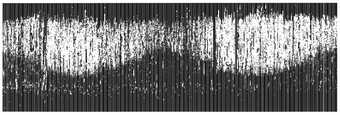
Fig.9
Susan Morris
Sun Study 2010–2011 2012
Actigraph, archival inkjet on paper
© Susan Morris
Actiwatches are used for medical research into sleeping and waking patterns and since 2005 I have been wearing them for short periods of time (up to three weeks) to produce inkjet prints of graphs that translate the level and duration of my activity and rest into blocks of colour organised along a timeline. Following scientific convention, in a spectrum going from black to red, the higher the level of activity, the brighter the colour used. In January 2010 I started wearing one of the watches continually, collecting the data at the end of each year and sending it to a Jacquard loom (incidentally a precursor to the modern computer). This translated the information as numerical values into coloured thread to produce large tapestries that look like thermographic visualisations of activity outside of normal vision, and reveal a restless body organised across calendrical time, in relation to the earth’s movement around the sun.83 The works document my habits, my timekeeping, as well as the times when, forgetting myself, perhaps, I strayed from the usual routine, for example by working all night then sleeping all day. These slips manifest themselves in the occasional, single, vertical column of brightly coloured data that streams like rain into the central, dark areas of the tapestry indicating ‘little or no activity’, the usual state of affairs during the night (figs.10 and 11).
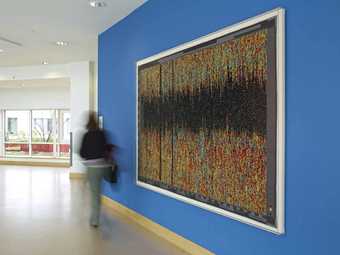
Fig.10
Susan Morris
Installation shot of SunDial:NightWatch_Sleep/Wake_2011 2012 in John Radcliffe Hospital, Oxford
Silk and wool yarn tapestry
Courtesy Susan Morris
Photograph © Stephen White

Fig.11
Susan Morris
Detail of SunDial:NightWatch_Sleep/Wake_2011 2012
Silk and wool yarn tapestry
© Susan Morris
In 2009 I also started work on a series of Motion Capture Drawings. Made in a high-tech studio at Newcastle University, I recorded myself working on a new Plumb Line Drawing and, in another session a year later, two new Architectural Drawings (of 3 Redacre Road) while wearing reflectors attached to various parts of my body including my hands, feet, elbows, knees, head and between my shoulder blades (fig.12). The data collected during these sessions was converted into line, using algorithms, and printed onto inkjet paper. Here the build-up of black ink, solidifying like accumulated soot, makes visible that which would otherwise remain unseen, that which occurs simultaneously and as if underneath a set of marks as they are being laid down: one in the light of day, one unfolding in the darkness of a digital recording. The thin, white, spidery line in these drawings does not actually exist; it is simply where the ink is not. The unmarked paper – signifying an absence that converges on, or stands in for the indecipherable entanglement of lines and the pooling of ink in the Architectural Drawings, or the deposits of ash and the broken strings of the Plumb Line Drawings – occupies a space parallel to these marks, a place where space flips, as if elasticised, and the simultaneity of inside and outside announces itself as a felt presence.
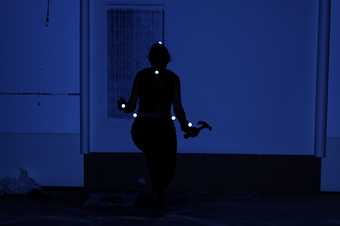
Fig.12
Documentary photograph of motion capture studio
Courtesy Susan Morris
Thus the Motion Capture Drawings emerge from the darkness or disappear into it, as if eclipsed by it. The mark that registers, like the air currents in Marey’s experiments made visible by suspended particles of smoke, drifts, like a cloud, beneath the dense black of the powdery ink. These pieces can only be made using digital technology, as this is the only way I can collect data from ‘no place’, the body, from ‘activity’ that does not have any definite, traceable, physical referent, yet that is governed, grounded or ‘earthed’ like an electrical device, and where some sort of ‘dumb condensation of libido’ collects like rain and writes itself, as ‘void’ (figs.13–16).84
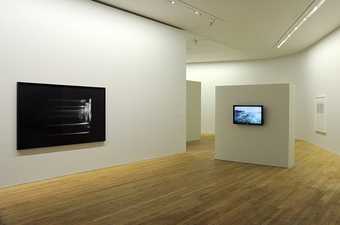
Fig.13
Installation shot of Motion Capture: Drawing and the Moving Image, Lewis Glucksman Gallery, University College Cork
Courtesy Susan Morris
Photograph © Matthew Packer

Fig.14
Installation shot of Susan Morris: Untitled Motion Capture Drawings, Art Exchange, University of Essex, 2012
Courtesy Susan Morris
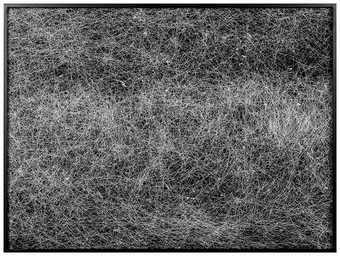
Fig.15
Susan Morris
MCD 1:1 Detail No.3 2012
1000 x 750 mm
Archive inkjet on Hahnemühle paper
© Susan Morris

Fig.16
Susan Morris
MCD_Left Elbow_Facing View 2012
Archive inkjet on Hahnemühle paper
© Susan Morris
In Honoré de Balzac’s tale The Unknown Masterpiece (1837), the artist declares that ‘there’s no such thing as drawing’ because there are ‘no lines in Nature’, but his art ends in catastrophe, in nothing but a ‘wall of paint’.85 A line is necessary in order to provide a structure for that which cannot be represented, to hold or contain it. The ideal form for this would, it seems, be a diagram or grid: chiasmic – intertwined with nothingness – or quaternion – a scattered field or set of fluid, mobile and empty relations. I would argue that digitalisation also provides a more direct version of the mark I am interested in, in that it can give form to – make manifest – phenomena that are invisible or appear to come from nowhere. Digital recording produces ‘Real’ marks, not imaginary constructs or representations. Rather than encoding reality, therefore, I can imprint it. Through the use of devices that store data which is, so to speak, recorded ‘in the dark’, I can produce a line that demarcates emptiness, is suspended in emptiness. This is a mark that delineates nature in its absence, as the (in)articulation of being.
I have a number of other ideas that drive my practice – guidelines, so to speak – that I use when making decisions about my work. These include my feeling that there should be some sort of logic or rule to produce, engineer or generate this mark and at the same time there should be some sort of break with this rule, a kind of rebelliousness; what Breton would call a ‘diseducation’.86 Following Breton, I believe there should be a necessary, wordless pleasure involved in drawing, a convulsive blindness, which can only occur in a mark that is laid down involuntarily.87 In this way, these rather dry and diagrammatic works are also always saturated with those aspects of the self that are most incomprehensible, such as laughter or tears, paroxysms that are spontaneous, unpredictable and impossible to control or measure. Finally, I think that to achieve its aims, my work needs to evolve as a kind of incompatible series, made up of interchangeable outputs (I do not say media): a set of ‘comparable impossibilities’ that reflect the invisible and insistent presence of a homeless, unlocatable, body.88
Yet there is a paradoxical impossibility to this endeavor, for I cannot literally stage my own disappearance. I cannot shift consciously to ‘not I’. The work described above may be a record of things of which I was not conscious, but in staging the work, in creating an image from it, ‘I’ return.89 As the maker, who is always and simultaneously the viewer of the work, I remain trapped – suspended between a system of representation that leaves me out and the ‘lure of space’ that devours me – like a spider entangled in her own web.90
